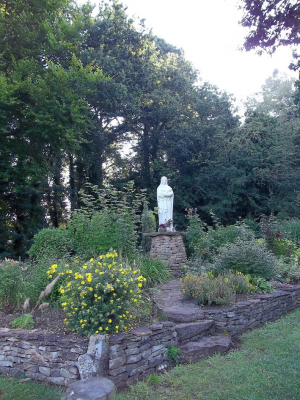Our Lady of Godalming, uniquely Mother

Source: English Catholic History Association
Tyr, the Norse deity who gave his name to Tuesday, was an immensely brave warrior and the son of Odin. He epitomised single combat, victory, heroic glory and justice.
Fenris, the giant wolf, threatened to eat the sun and plunge the world into darkness unless a courageous deity dared put a hand into the monster's mouth. All but Tyr refused. As he plunged his hand between the wolf's teeth, the other gods bound it with an unbreakable silken rope fashioned from the sound of a cat's footsteps, a woman's beard, the roots of a mountain, the longings of the bear, the voice of fishes and the spittle of birds. Furious Fenris bit off Tyr's arm. Henceforth, people honoured Tyr's self-sacrifice by portraying him with one arm.
When the Saxons invaded Britain around the year 450, they brought with them their worship of Tyr, whom they called Saxnot (from sax, a sword) and built shrines throughout Britain.
Christianity first came to Britain in the first century AD during the Roman occupation. The pagan Saxons created Godalming's shrine to Tyr between 568-650, but they encountered an increasingly Christian population. By 686, most pagan shrines were destroyed, fallen into disrepair or re-dedicated to Our Lady or Christian saints. The shrine to Tyr might have already become Christian when missionaries arrived in the future Godalming. Great care was taken not to destroy the shrine so 'that the people, seeing their temples are not destroyed, may abandon their error and flocking more readily to their accustomed resorts, may come to adore and know the true God'.
No surviving records describe the Marian dedication of the Godalming shrine, which eventually became the 'Minster', or mother church of the area, implying both local importance and the presence of one or more monks. However, a small spring nearby could have inspired the name 'Ladywell' which long predates the arrival of the Franciscan Missionaries of the Divine Motherhood (FMDM), who currently own the land.
Godalming's ninth century parish of Ss Peter and Paul led to decreased footfall at the now ancient shrine to Our Lady, of which it was written in 1220:
'Celebrations are now held only three times during the year, that is to say, on the Eve of the Assumption the Purification and Nativity of the Blessed Virgin and this is done by reason of the great devotion for that place. And there has been a cemetery there from ancient times.'
After Becket's murder in 1170, the shrine became a wayside chapel on the Pilgrims' Way to Canterbury.
In 1860, the shrine's partial excavation revealed stone foundations and a nave of 21ft x 14ft with an eastern extension 12ft x 11ft. An eastern chancel was subdivided into two sections, each about 21ft x 5ft. In the farthest compartment were found nine skeletons lying east to west. These were covered over and the site marked with original stones.
During the Reformation, the shrine fell into disuse but was never forgotten. When the FMDMs acquired the land in 1956, they built the present shrine over the original site. Its cornerstones are from the earlier church.
They restored the earlier devotion to Our Lady. With no surviving image of Mary from the original shrine, the FMDMs erected their own Congregational statue of the Divine Motherhood. The first Mass since the Reformation was celebrated at the shrine on 7 September 1979.















